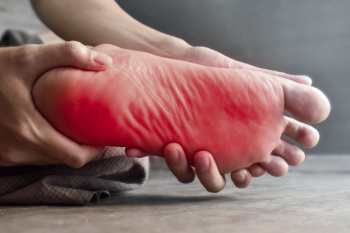Items filtered by date: February 2024
What Can Be Done for Ankle Sprains

Ankle sprains are common, especially among teenagers and young adults. However, since an ankle sprain can result from simple missteps, they can happen to anyone. Most ankle sprains occur when the foot twists inward, hurting the ligaments on the outside of the ankle. Sometimes, the injury is higher up, affecting other parts around the ankle. Podiatrists look for certain signs, like pain in specific areas or trouble walking right after the injury. To help with pain and healing, patients might be counseled to rest and elevate their injured ankle for a few days. They might also be prescribed special ankle supports or braces to reduce swelling and protect the injured area. It is important to start moving the ankle early, as resting too much can slow down healing. If pain from an ankle sprain is severe or persistent, it is important to make an appointment with a podiatrist for an accurate diagnosis and relief methods.
Ankle sprains are common but need immediate attention. If you need your feet checked, contact one of our podiatrists from Lakewood Family Foot and Ankle. Our doctors can provide the care you need to keep you pain-free and on your feet.
How Does an Ankle Sprain Occur?
Ankle sprains take place when the ligaments in your ankle are torn or stretched beyond their limits. There are multiple ways that the ankle can become injured, including twisting or rolling over onto your ankle, putting undue stress on it, or causing trauma to the ankle itself.
What Are the Symptoms?
- Mild to moderate bruising
- Limited mobility
- Swelling
- Discoloration of the skin (depending on severity)
Preventing a Sprain
- Wearing appropriate shoes for the occasion
- Stretching before exercises and sports
- Knowing your limits
Treatment of a Sprain
Treatment of a sprain depends on the severity. Many times, people are told to rest and remain off their feet completely, while others are given an air cast. If the sprain is very severe, surgery may be required.
If you have suffered an ankle sprain previously, you may want to consider additional support such as a brace and regular exercises to strengthen the ankle.
If you have any questions please feel free to contact our office located in Lakewood, CA . We offer the newest diagnostic and treatment technologies for all your foot and ankle needs.
Insights Into Hammertoe

Hammertoe, a prevalent foot deformity, manifests as an abnormal bending of the toe joints, causing toes to resemble a hammer's shape. This condition typically affects the second, third, or fourth toe, resulting from an imbalance in the muscles, tendons, and ligaments that control toe movement. Common causes of hammertoe include wearing ill-fitting shoes, toe injuries, and underlying foot conditions like arthritis or bunions. Over time, hammertoes can become rigid and painful, making walking and wearing shoes uncomfortable. Recognizing the signs, such as toe stiffness, corns, or calluses, is vital for early intervention and treatment. While conservative measures like wearing roomy shoes, toe exercises, and padding can alleviate symptoms, severe cases may require surgical correction to realign the toe joints and restore functionality. With proper care and attention, individuals can manage hammertoe effectively, minimizing discomfort and maintaining optimal foot health. If you have developed hammertoe, it is strongly suggested that you consult a podiatrist who can determine what the best course of treatment is for you.
Hammertoe
Hammertoes can be a painful condition to live with. For more information, contact one of our podiatrists from Lakewood Family Foot and Ankle. Our doctors will answer any of your foot- and ankle-related questions.
Hammertoe is a foot deformity that affects the joints of the second, third, fourth, or fifth toes of your feet. It is a painful foot condition in which these toes curl and arch up, which can often lead to pain when wearing footwear.
Symptoms
- Pain in the affected toes
- Development of corns or calluses due to friction
- Inflammation
- Redness
- Contracture of the toes
Causes
Genetics – People who are genetically predisposed to hammertoe are often more susceptible
Arthritis – Because arthritis affects the joints in your toes, further deformities stemming from arthritis can occur
Trauma – Direct trauma to the toes could potentially lead to hammertoe
Ill-fitting shoes – Undue pressure on the front of the toes from ill-fitting shoes can potentially lead to the development of hammertoe
Treatment
Orthotics – Custom made inserts can be used to help relieve pressure placed on the toes and therefore relieve some of the pain associated with it
Medications – Oral medications such as anti-inflammatories or NSAIDs could be used to treat the pain and inflammation hammertoes causes. Injections of corticosteroids are also sometimes used
Surgery – In more severe cases where the hammertoes have become more rigid, foot surgery is a potential option
If you have any questions please contact our office located in Lakewood, CA . We offer the newest diagnostic and treatment technologies for all your foot and ankle needs.
Plantar Warts Can Be Treated!
Finding Shoes for Trail Running

Trail running is an exhilarating activity that invites people of all preferences and ideologies to explore nature's paths. And with the right pair of shoes, anyone can conquer the trails with confidence. Before purchasing trail running shoes, there are two vital considerations to keep in mind. These can include your foot type and the terrain you will be tackling. First, understanding your foot type is essential for finding the perfect fit. Consider factors like the stiffness or pliability of the shoe, whether you need a neutral or stable base, and if you require a wide or narrow fit. Additionally, think about the heel to toe drop that suits your running style best. Equally important is selecting shoes tailored to the terrain you will be traversing. Such factors include trails with uneven surfaces, smoother paths with gentle inclines, water crossings, or dryer routes. If you have experienced foot, toe, or ankle pain as the result of trail running, you may benefit from a gait analysis and thorough examination of your feet and shoes. It is suggested that you schedule an appointment with a podiatrist for further guidance.
You should always make sure your running shoes fit properly in order to avoid injury. For more information, contact one of our podiatrists from Lakewood Family Foot and Ankle. Our doctors can provide the care you need to keep you pain-free and on your feet.
Choosing the Right Running Shoe for Your Foot Type
Improper shoe sizing can cause a myriad of problems for your feet. Shoes that don’t fit you properly can lead to muscular imbalances in your body, which can result in foot, knee, and hip injuries.
Tips for Finding the Right Running Shoe
- Make sure you have a thumb’s width of wiggle room between the end of your longest toe and the front of the shoe.
- There should be little to no slipping at the heel
- Don’t assume your size in one shoe brand will be your size in another
- Do not lace up your shoes too tightly
- Walk around in the store with your new shoes before you buy them
If you have any questions please feel free to contact our our office located in Lakewood, CA . We offer the newest diagnostic and treatment technologies for all your foot and ankle needs.
Common Symptoms of Neuropathy in the Feet

Neuropathy, a condition characterized by damage to the nerves, frequently manifests with distinct symptoms in the feet. Sensory disturbances are common, with individuals experiencing tingling or a sensation akin to pins and needles. Numbness is another hallmark symptom, contributing to a reduced ability to perceive temperature and touch. Many individuals with neuropathy report a burning or stabbing pain in their feet that often disrupts daily activities. Muscle weakness may accompany these sensations, leading to difficulties in maintaining balance and coordination. The symptoms of neuropathy can be progressive, and as the condition advances, individuals may face challenges with mobility and foot function. Early recognition of these common symptoms is important for timely diagnosis and intervention. If you have neuropathy that is affecting your feet, it is strongly suggested that you are under the care of a podiatrist who can guide you toward relief and management techniques.
Neuropathy
Neuropathy can be a potentially serious condition, especially if it is left undiagnosed. If you have any concerns that you may be experiencing nerve loss in your feet, consult with one of our podiatrists from Lakewood Family Foot and Ankle. Our doctors will assess your condition and provide you with quality foot and ankle treatment for neuropathy.
What Is Neuropathy?
Neuropathy is a condition that leads to damage to the nerves in the body. Peripheral neuropathy, or neuropathy that affects your peripheral nervous system, usually occurs in the feet. Neuropathy can be triggered by a number of different causes. Such causes include diabetes, infections, cancers, disorders, and toxic substances.
Symptoms of Neuropathy Include:
- Numbness
- Sensation loss
- Prickling and tingling sensations
- Throbbing, freezing, burning pains
- Muscle weakness
Those with diabetes are at serious risk due to being unable to feel an ulcer on their feet. Diabetics usually also suffer from poor blood circulation. This can lead to the wound not healing, infections occurring, and the limb may have to be amputated.
Treatment
To treat neuropathy in the foot, podiatrists will first diagnose the cause of the neuropathy. Figuring out the underlying cause of the neuropathy will allow the podiatrist to prescribe the best treatment, whether it be caused by diabetes, toxic substance exposure, infection, etc. If the nerve has not died, then it’s possible that sensation may be able to return to the foot.
Pain medication may be issued for pain. Electrical nerve stimulation can be used to stimulate nerves. If the neuropathy is caused from pressure on the nerves, then surgery may be necessary.
If you have any questions, please feel free to contact our office located in Lakewood, CA . We offer the newest diagnostic and treatment technologies for all your foot care needs.




